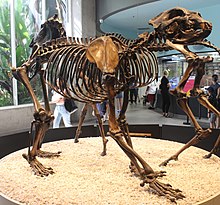
Back Arctodus AN دب قصير الوجه Arabic Qısasifət ayı Azerbaijani Arctodus Catalan ورچی ڕووخسار كورت CKB Arctodus Spanish خرسهای کوتاهچهره Persian Tylppäkuonokarhu Finnish Arctodus French דוב קצר-פנים HE
| Arctodus Temporal range:
| |
|---|---|

| |
| A. simus from the La Brea Tar Pits | |
| Scientific classification | |
| Domain: | Eukaryota |
| Kingdom: | Animalia |
| Phylum: | Chordata |
| Class: | Mammalia |
| Order: | Carnivora |
| Family: | Ursidae |
| Subfamily: | Tremarctinae |
| Genus: | †Arctodus Leidy, 1854 |
| Type species | |
| †Arctodus pristinus Leidy, 1854
| |
| Other species | |
| |

| |
| Arctodus simus range | |
| Synonyms | |
|
synonyms of A. pristinus
| |
Arctodus is an extinct genus of short-faced bear that inhabited North America during the Pleistocene (~2.5 Mya until 12,800 years ago). There are two recognized species: the lesser short-faced bear (Arctodus pristinus) and the giant short-faced bear (Arctodus simus). Of these species, A. simus was larger, is known from more complete remains, and is considered one of the most charismatic of North America's megafauna. A. pristinus was largely restricted to the Early Pleistocene of the Eastern United States, whereas A. simus had a broader range, with most finds being from the Late Pleistocene of the United States, Mexico and Canada. A. simus evolved from A. pristinus, but both species likely overlapped in the Middle Pleistocene. Both species are relatively rare in the fossil record.
Today considered to be an enormous omnivore, Arctodus simus is believed to be one of the largest known terrestrial carnivorans that has ever existed. However, Arctodus, like other bears, was highly sexually dimorphic. Adult A. simus ranged between 300 and 950 kilograms (660 and 2,090 lb), with females clustering at ≤500 kilograms (1,100 lb), and males around 800 kilograms (1,800 lb). The largest males stood at 1.67 metres (5 ft 6 in) at the shoulder, and up to 3.4 metres (11 ft) tall on their rear legs. Studies suggest that Arctodus simus browsed on C3 vegetation and consumed browsing herbivores such as deer, camelids, and tapir. A. simus preferred temperate open woodlands but was an adaptable species, taking advantage of many habitats and feeding opportunities.
Arctodus belongs to the Tremarctinae subfamily of bears, which are endemic to the Americas. Of these short-faced bears, Arctodus was the most widespread in North America. However, the genus was restricted to the Pleistocene. A. pristinus went extinct around 300,000 years ago, with A. simus disappearing ~12,800 years ago in the Late Pleistocene extinctions. The cause behind these extinctions is unclear, but in the case of A. pristinus, this was likely due to climate change and competition with other ursids, such as the black bear and Tremarctos floridanus. A. simus likely went extinct due to ecological collapse disrupting the vegetation and prey it relied on.
© MMXXIII Rich X Search. We shall prevail. All rights reserved. Rich X Search